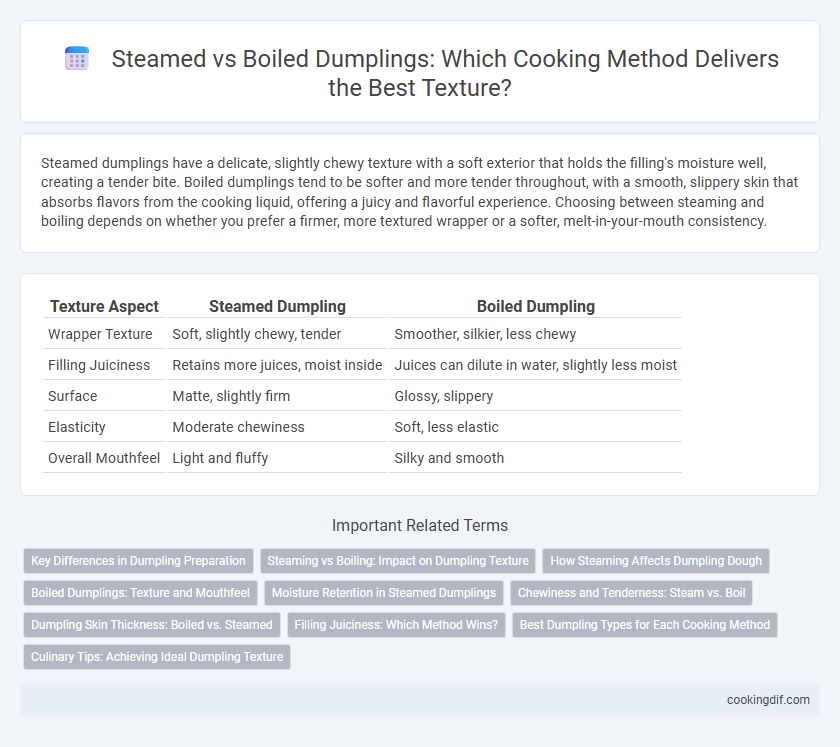Steamed dumplings have a delicate, slightly chewy texture with a soft exterior that holds the filling's moisture well, creating a tender bite. Boiled dumplings tend to be softer and more tender throughout, with a smooth, slippery skin that absorbs flavors from the cooking liquid, offering a juicy and flavorful experience. Choosing between steaming and boiling depends on whether you prefer a firmer, more textured wrapper or a softer, melt-in-your-mouth consistency.
Table of Comparison
| Texture Aspect | Steamed Dumpling | Boiled Dumpling |
|---|---|---|
| Wrapper Texture | Soft, slightly chewy, tender | Smoother, silkier, less chewy |
| Filling Juiciness | Retains more juices, moist inside | Juices can dilute in water, slightly less moist |
| Surface | Matte, slightly firm | Glossy, slippery |
| Elasticity | Moderate chewiness | Soft, less elastic |
| Overall Mouthfeel | Light and fluffy | Silky and smooth |
Key Differences in Dumpling Preparation
Steaming dumplings results in a soft, tender texture with a slightly chewy outer layer, preserving the dumpling's moisture and enhancing the filling's juiciness. Boiling dumplings creates a smoother, more elastic skin that is firmer and less delicate due to direct contact with boiling water. The choice between steaming and boiling significantly impacts the texture, with steaming favoring a fluffier bite and boiling providing a denser, more resilient dumpling casing.
Steaming vs Boiling: Impact on Dumpling Texture
Steaming dumplings preserves their delicate, slightly chewy outer skin while locking in moisture, resulting in a soft and fluffy texture. Boiling dumplings creates a tender, smooth surface but can make the dough overly saturated, potentially leading to a denser, less structured bite. The choice between steaming and boiling directly affects the dumpling's texture, with steaming offering a light, airy feel and boiling yielding a moist, supple consistency.
How Steaming Affects Dumpling Dough
Steaming dumplings causes the dough to retain moisture, creating a soft and slightly chewy texture that highlights the delicate wrapper. The gentle heat of steam allows the dumpling skin to cook evenly without becoming soggy or tough, preserving a smooth surface. This method enhances the dough's elasticity and subtle flavor, making it ideal for thin-skinned dumplings.
Boiled Dumplings: Texture and Mouthfeel
Boiled dumplings have a soft, tender texture that absorbs the cooking water, resulting in a slightly chewy yet delicate mouthfeel. The boiling process allows the dough to remain moist and supple, enhancing the overall juiciness of the filling with every bite. This method produces dumplings that are less dense compared to steamed ones, offering a melt-in-the-mouth sensation paired with a subtle elasticity.
Moisture Retention in Steamed Dumplings
Steamed dumplings retain moisture more effectively due to the gentle cooking process that steams the dough and filling evenly, preventing drying out. The steam creates a moist environment, keeping the dough soft and the filling juicy, enhancing textural contrast. In comparison, boiled dumplings may absorb water and lose some internal moisture, resulting in a denser texture.
Chewiness and Tenderness: Steam vs. Boil
Steamed dumplings retain more chewiness due to the gentle cooking process that preserves the dough's elasticity and firmness. Boiled dumplings tend to be more tender and softer, as the direct water heat breaks down the dough structure more thoroughly. Chewiness in steamed dumplings contrasts with the delicate tenderness found in boiled dumplings, highlighting different texture preferences in dumpling preparation.
Dumpling Skin Thickness: Boiled vs. Steamed
Steamed dumplings typically have a slightly thicker, chewier skin that retains moisture and offers a tender bite, enhancing the filling's juiciness. Boiled dumplings feature thinner, softer skins that absorb water, providing a delicate, smooth texture that blends seamlessly with the broth or dipping sauce. Skin thickness directly influences the dumpling's mouthfeel, where steamed skins maintain structural integrity while boiled skins emphasize lightness and softness.
Filling Juiciness: Which Method Wins?
Steamed dumplings retain more filling juiciness by trapping moisture inside, resulting in a tender, succulent bite. Boiled dumplings often lose some juices to the cooking water, leading to a slightly less moist filling. For maximum filling juiciness, steaming is the preferred cooking method.
Best Dumpling Types for Each Cooking Method
Steamed dumplings excel with delicate wrappers that maintain a tender yet slightly chewy texture, such as xiao long bao and har gow, which showcase juicy fillings and translucent skins. Boiled dumplings like jiaozi and mandu benefit from the cooking method's ability to evenly cook thicker, sturdier wrappers, resulting in a soft, pliable texture that complements hearty fillings. Choosing the appropriate cooking method enhances the overall bite and flavor experience based on dumpling type, as steaming preserves moisture while boiling imparts a distinct softness.
Culinary Tips: Achieving Ideal Dumpling Texture
Steamed dumplings offer a soft, tender texture with a slightly chewy exterior, preserving the filling's moisture and nuanced flavors. Boiled dumplings deliver a smoother, denser skin that complements broth or soup dishes, creating a more substantial bite. For optimal results, steam dumplings on a lined basket for 8-10 minutes or boil gently until they float, ensuring a delicate yet firm texture.
Steamed vs Boiled for dumpling texture Infographic

 cookingdif.com
cookingdif.com